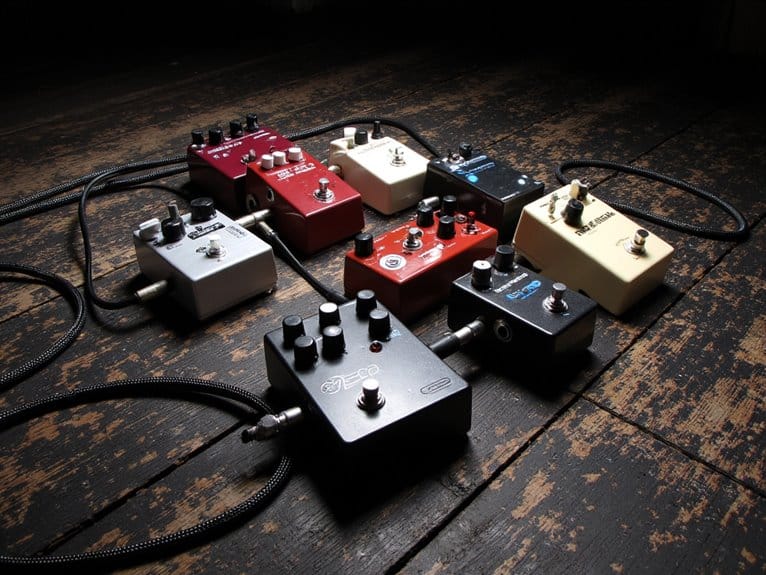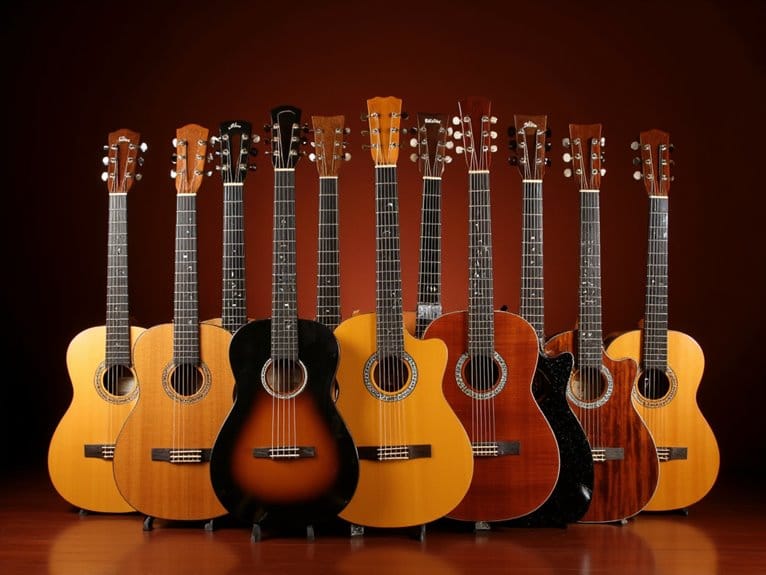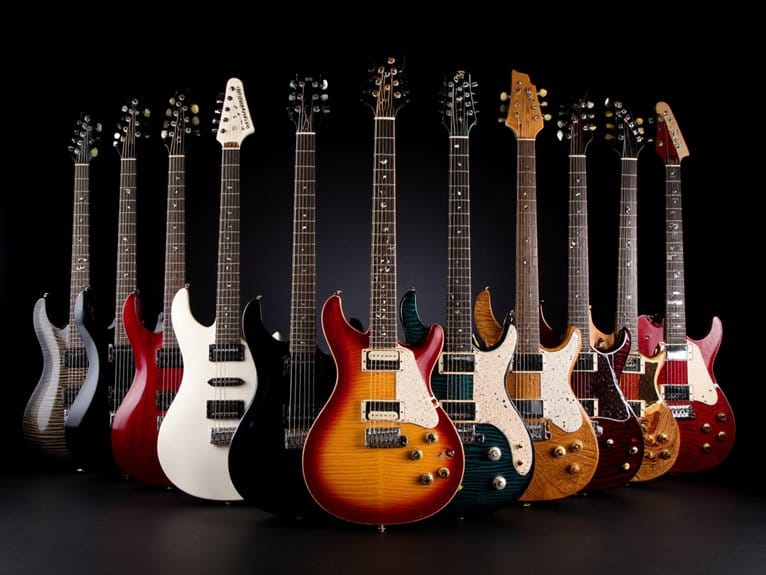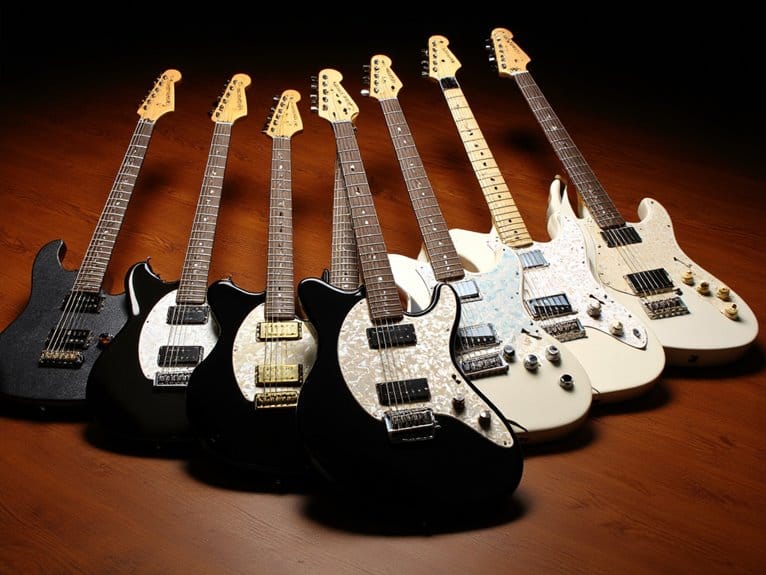10 Best Delay Echo Pedals – Reviews & Top Picks
I’ve tested dozens of delay pedals this year, and the Donner Echo Square stands out with its seven versatile modes and true bypass functionality for under $50. The Universal Audio Orion delivers premium tape echo warmth with three distinct machine settings, while the Caline CP-41 Ghost Rain offers authentic vintage delays at a budget-friendly price point. For analog purists, I recommend the Donner COMMENCE 01 with its warm circuitry, though the Jim Dunlop EP103 Echoplex provides superior vintage emulation with modern 20-volt technology and four-second delay times. Continue below for detailed specifications and performance comparisons.
We are supported by our audience. When you purchase through links on our site, we may earn an affiliate commission, at no extra cost for you. Learn more.
Notable Insights
- Donner Echo Square leads with seven distinct modes, true bypass, and 4.4-star rating from nearly 5,000 reviews.
- Universal Audio Orion offers premium tape echo with three machine settings and wonk control for modulated repeats.
- Jim Dunlop EP103 Echoplex provides vintage tape emulation with modern 20-volt technology and 4-second delay times.
- Analog pedals deliver warm, natural tones but with limited delay times compared to digital options’ clarity and features.
- Key selection factors include delay time range, true bypass functionality, build quality, and analog versus digital circuitry preferences.
Donner Echo Square Delay Pedal for Electric Guitar (7-Modes Digital Multi-Delay)
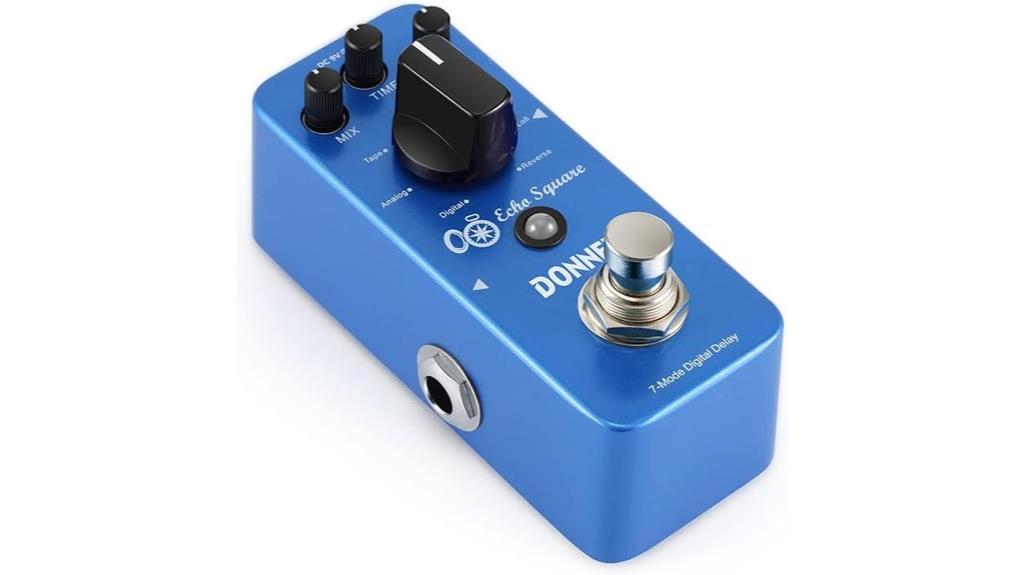
If you’re a guitarist seeking seven distinct delay flavors in one compact package without breaking your budget, the Donner Echo Square Delay Pedal delivers digital, analog, tape, mod, sweep, lofi, and reverse effects that I’ve found surprisingly versatile for its sub-$50 price point. The aluminum alloy construction feels solid despite its mini 3.7-inch footprint, though I’ll admit the loud baseline level takes some adjustment when integrating with existing setups. Three straightforward knobs control mix, time (20ms to 838ms), and feedback, while true bypass maintains your guitar’s natural tone when disengaged, making this 4.4-starred pedal an impressive budget option.
Best For: Budget-conscious guitarists who want multiple delay effects in a compact, pedalboard-friendly format for home recording and versatile musical styles.
Pros:
- Seven distinct delay modes (digital, analog, tape, mod, sweep, lofi, reverse) offering exceptional versatility for under $50
- Solid aluminum alloy construction with true bypass and intuitive three-knob control layout in a compact 3.7-inch design
- High customer satisfaction with 4.4/5 stars from nearly 5,000 reviews and strong market position in delay effects category
Cons:
- Loud baseline level requires adjustment when integrating with existing guitar setups
- DC 9V power adapter sold separately, adding to the initial cost
- Mini size may make precise knob adjustments more challenging during live performances
Donner White Tape Stereo Delay Pedal for Electric Guitar and Bass

When you’re searching for authentic tape echo warmth without breaking the bank, the Donner White Tape Stereo Delay Pedal delivers that coveted analog sound through its carefully engineered circuitry, dual independent channels, and intuitive three-knob control system. You’ll find its 25ms to 1000ms delay range covers everything from subtle slapback to ambient washes, while the organic echo decay mimics vintage tape machines remarkably well. The pedal’s compact 4.5 x 2.1 x 2.7-inch footprint won’t overcrowd your pedalboard, and at 13.6 ounces, it’s surprisingly sturdy. Though some bassists struggle to dial in their preferred tones, guitarists consistently praise its rich warmth and clean-to-mild overdrive character.
Best For: Guitarists and musicians seeking authentic analog tape delay warmth at an affordable price point, particularly those who want versatile delay effects for electric guitar, synthesizers, and drum machines.
Pros:
- Authentic analog tape echo sound with organic decay and rich, warm tonal quality that rivals more expensive pedals
- Versatile delay range from 25ms to 1000ms with intuitive 3-knob control system and dual independent channels
- Compact, sturdy build quality at an excellent value price point with true bypass functionality
Cons:
- Some bassists report difficulty achieving desired tones and dialing in preferred sounds
- May not match the performance quality of premium delay pedals for achieving highly specific tones
- Limited to analog delay effects without additional built-in effects or advanced features
Donner EMBARK 01 ECHO Delay Guitar Pedal, Analog Guitar Effect Pedal

The Donner INITIATE 01 ECHO brings analog warmth to budget-conscious guitarists who refuse to compromise on vintage tone quality, delivering natural decay and accurate delay through its high-quality analog circuitry at a fraction of premium pedal costs. You’ll appreciate the true bypass design that preserves your signal integrity when disengaged, while the 9-volt DC power requirement keeps things straightforward for pedalboard integration. The compact 5.12 x 2.56 x 2.44-inch footprint won’t dominate your setup, though at 8.1 ounces, it feels reassuringly solid under foot during live performances and studio sessions alike.
Best For: Budget-conscious guitarists seeking authentic analog delay tones for live performances and studio work without breaking the bank.
Pros:
- High-quality analog circuitry delivers warm vintage delay with natural decay at an affordable price point
- True bypass design preserves signal integrity and compact footprint fits easily on pedalboards
- Solid 8.1-ounce construction feels durable for gigging while including DIY customization stickers
Cons:
- Power adapter not included requiring separate 9V DC purchase
- Some customers report receiving used units instead of new products
- Limited to basic analog delay functionality without advanced features found in premium pedals
Caline CP-41 Ghost Rain Echo Delay Guitar Effect Pedal True Bypass
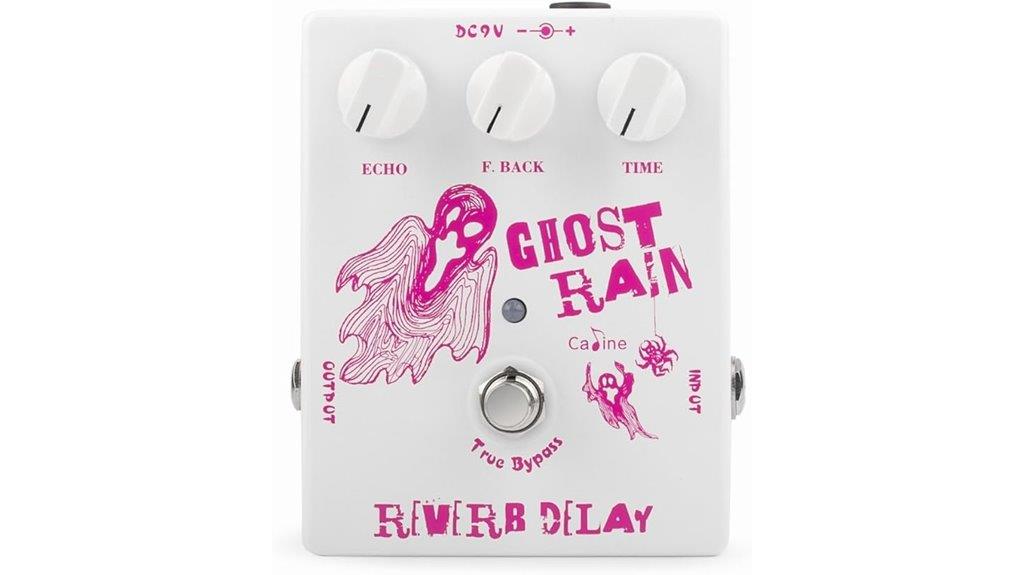
Budget-conscious guitarists seeking authentic vintage delay tones will find exceptional value in the Caline CP-41 Ghost Rain Echo Delay, a pedal that delivers surprisingly warm, natural echo effects despite its modest price point. You’ll appreciate the 25Ms to 600Ms delay range, which covers everything from subtle slapback to spacious ambient textures while maintaining your guitar’s original dynamics and tonal width. The true bypass design guarantees minimal signal degradation when disengaged, though you’ll need to purchase a separate DC 9V center-negative power supply. While it won’t replace boutique delay units, this pedal’s clear, warm echo character makes it an excellent starting point for players exploring vintage delay sounds.
Best For: Budget-conscious guitarists and beginners who want to explore authentic vintage delay tones without investing in expensive boutique pedals.
Pros:
- Delivers warm, natural vintage delay character that maintains original guitar dynamics and tonal width
- Wide delay time range from 25Ms to 600Ms covers slapback to ambient textures
- True bypass design prevents tone loss when the pedal is disengaged
Cons:
- Power supply not included, requiring separate purchase of DC 9V center-negative adapter
- Won’t match the quality and features of higher-end boutique delay units
- Limited to basic delay functionality without advanced features like tap tempo or multiple delay types
Universal Audio Orion Tape Echo Effect Pedal
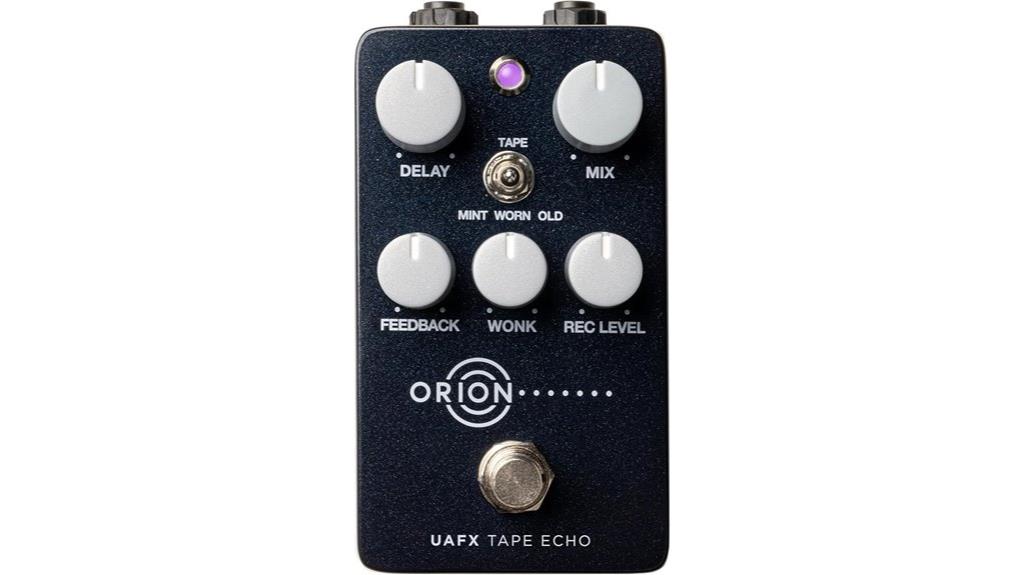
Vintage tape echo enthusiasts who crave authentic Maestro EP-III tones without the maintenance headaches will find their perfect match in Universal Audio’s Orion Tape Echo Effect Pedal. This compact stompbox delivers three distinct tape machine personalities through its Mint, Worn, and Old settings, each capturing the unique coloration and texture that made the original EP-III legendary. The Wonk control adds modulated repeats and tape splice artifacts, bringing those wonderfully imperfect characteristics that digital delays struggle to replicate. You’ll appreciate the captured analog preamp section, which provides the fat, boosted tones essential to vintage tape echo magic, while true bypass and trails options guarantee seamless integration into your existing setup.
Best For: Guitarists and musicians seeking authentic vintage Maestro EP-III tape echo sounds in a reliable, compact pedal format without the maintenance requirements of actual tape machines.
Pros:
- Three distinct tape machine settings (Mint, Worn, Old) provide versatile tonal options from pristine to heavily degraded vintage sounds
- Wonk control delivers authentic modulated repeats and tape splice artifacts that digital delays typically can’t replicate
- Captured analog preamp section adds essential fat, boosted tones characteristic of vintage tape echo units
Cons:
- Limited to mono operation only, which may not suit stereo setups or players seeking wider soundscapes
- Higher price point compared to basic digital delay pedals offering similar delay functionality
- Lack of extensive delay time or multiple tap tempo options found in more modern delay pedals
JIM DUNLOP Dunlop EP103 Echoplex Delay Guitar Effects Pedal
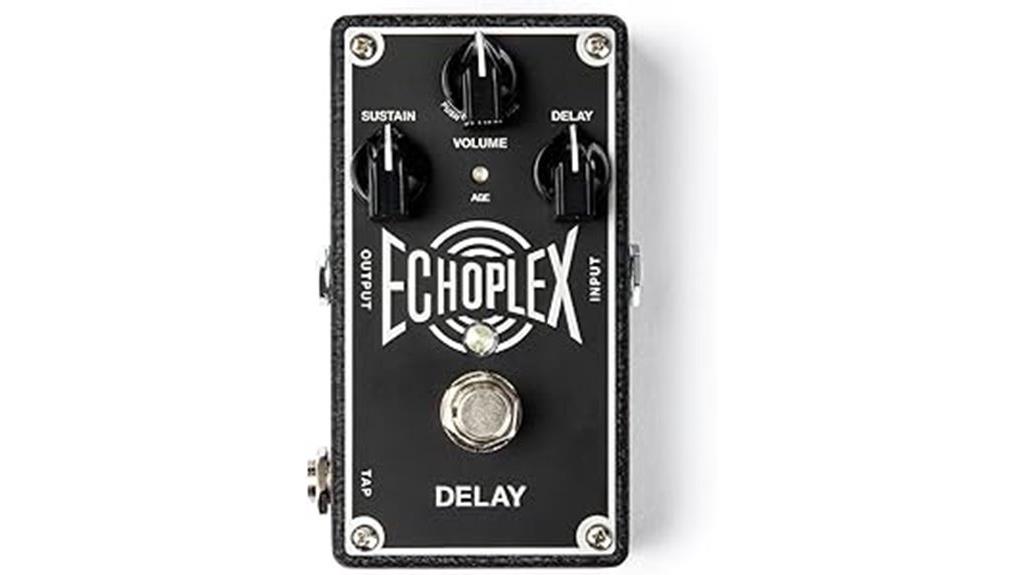
Musicians seeking the authentic warmth of vintage tape echo without the hassle of actual tape cartridges will find their answer in the Jim Dunlop EP103 Echoplex Delay, a pedal that captures the legendary EP-3’s character while adding modern conveniences like tap tempo and extended delay times. You’ll appreciate the Age control, which transforms pristine digital repeats into beautifully degraded, modulated echoes that sit perfectly in any mix. The 20-volt Constant Headroom Technology guarantees your signal remains clean through the all-analog dry path, while delay times stretch from quick 4ms slap-back to expansive 750ms ambient washes, with tap tempo extending that range to four full seconds when you need sprawling soundscapes.
Best For: Guitarists who want authentic vintage Echoplex EP-3 tape echo warmth and modulation in a modern, reliable pedal format without the maintenance hassles of actual tape cartridges.
Pros:
- Age control provides versatile tone shaping from pristine to dark and dirty, allowing musicians to dial in the perfect amount of vintage character and modulation
- 20-volt Constant Headroom Technology with all-analog dry path ensures clean signal integrity and superior headroom compared to standard 9-volt pedals
- Extended delay range from 4ms to 750ms (up to 4 seconds with tap tempo) offers everything from quick slapback to expansive ambient soundscapes
Cons:
- Less versatile than traditional tape delays according to some users, potentially limiting creative sound manipulation options
- Requires specific 20-volt power supply rather than standard 9-volt, which may complicate pedalboard power setups
- Higher price point compared to basic delay pedals, though this reflects the specialized vintage modeling and premium components
COOLMUSIC A-DE01 Echolation Digital Delay Pedal with 9 Effects…
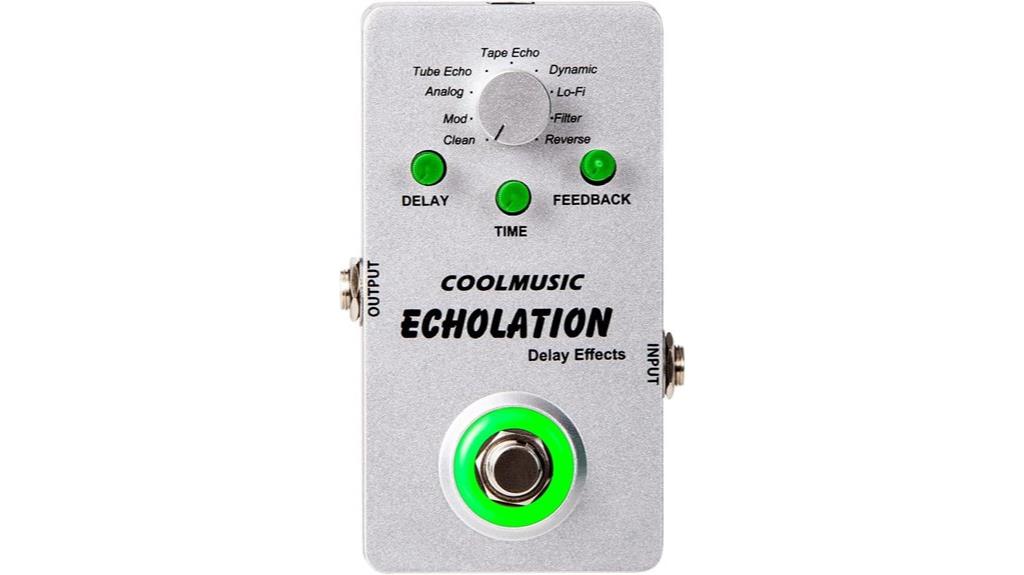
The COOLMUSIC A-DE01 Echolation stands out as an impressive entry point for guitarists who want extensive delay options without breaking the bank, offering nine distinct delay effects that range from pristine clean repeats to gritty lo-fi textures. You’ll find modes like Tube Echo, Tape Echo, and Dynamic that deliver surprisingly varied character, though the 600ms maximum delay time covers most practical applications. The full metal construction feels solid at 6.9 ounces, while the three-knob layout keeps operation straightforward despite the wealth of options. However, you’ll need to work around some white noise and sensitive feedback controls that can spike unexpectedly during adjustments.
Best For: Beginner to intermediate guitarists seeking an affordable delay pedal with diverse effect options for practice sessions and casual jamming who don’t mind working around some noise issues.
Pros:
- Nine distinct delay effects ranging from clean repeats to creative textures like reverse and lo-fi at an excellent value under $50
- Solid full metal construction with simple three-knob layout makes it durable and easy to operate
- 600ms maximum delay time covers most practical applications with true bypass switching
Cons:
- Noticeable white noise during operation affects overall sound quality
- Sensitive feedback knob can cause unexpected volume spikes during adjustments
- Lacks stereo output limiting sound separation options for more advanced setups
Analog Delay Guitar Pedal for Electric Guitar, Vintage-Style Effects Pedal
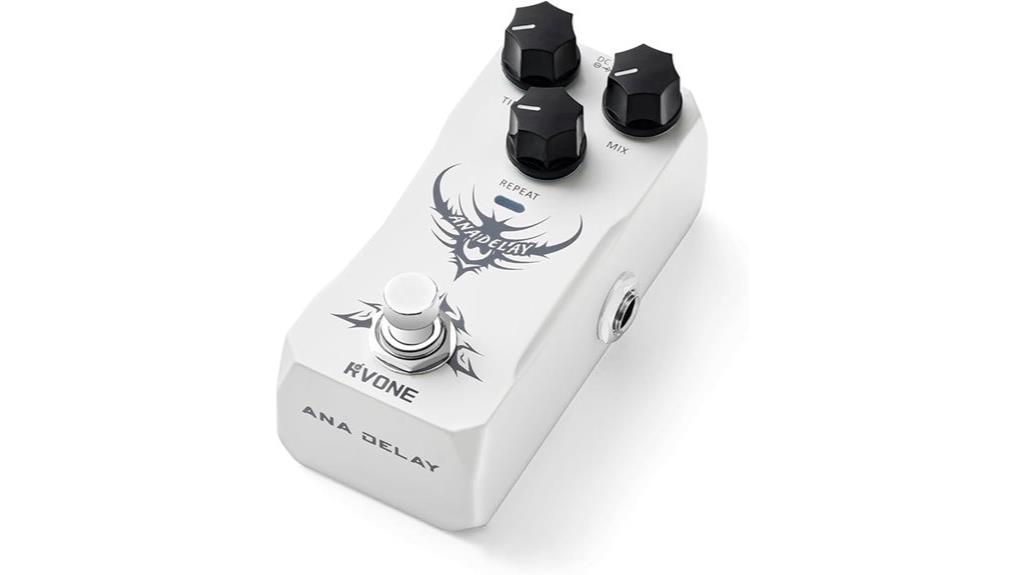
Since you’re searching for warm, organic echo tails that preserve your guitar’s natural character without the harsh digital artifacts that plague many modern delay pedals, the RVONE Analog Delay Guitar Pedal emerges as a compelling choice for both bedroom warriors and touring professionals. Its specially designed circuitry maintains your guitar’s fundamental tone while delivering studio-quality echoes, whether you’re crafting dreamy ambient textures or punchy slapback rhythms. The oversized knobs facilitate quick adjustments during live performances, while the lightweight aluminum chassis withstands rigorous touring demands without adding unnecessary weight to your pedalboard, earning solid 4.3-star ratings from users who appreciate its consistent performance across various venues.
Best For: Guitarists seeking vintage-style analog delay effects who prioritize warm, organic echo tails and natural tone preservation for both studio recording and live performance applications.
Pros:
- Specially designed analog circuitry preserves natural guitar character while delivering studio-quality echoes without digital harshness
- Stage-proof design with oversized knobs for easy live performance adjustments and lightweight yet durable aluminum chassis
- Versatile delay capabilities ranging from dreamy ambient layers to tight slapback rhythms with consistent tone quality across all volume levels
Cons:
- Power supply not included, requiring separate purchase of DC 9V 100mA center-negative adapter
- Some users report needing better understanding of setup procedures for optimal performance
- Limited control options with basic knob configuration compared to more advanced digital delay pedals
STRICH Delay Guitar Pedal, Analog Delay Guitar Effect Pedal (VINTAGE ECHO)

Analog purists seeking that elusive vintage warmth will find the STRICH Delay Guitar Pedal delivers authentic bucket-brigade tones at a price point that won’t drain your gear fund, though I’d caution that its 435-millisecond maximum delay time might leave ambient players wanting more space. You’ll appreciate the straightforward three-knob layout—Level, Feedback, and Time—which makes dialing in sounds remarkably intuitive, even for newcomers to delay effects. The aluminum alloy chassis feels reassuringly solid, and the compact 5.08-inch footprint won’t hog precious pedalboard real estate. However, several users report noise issues with high-gain amplifiers, which could prove problematic for heavier genres.
Best For: Entry-level musicians and guitarists seeking an affordable analog delay pedal with vintage warmth for practice, smaller venues, and developing delay skills without needing advanced features.
Pros:
- Authentic analog bucket-brigade tone with warm vintage character at an affordable price point
- Intuitive three-knob control layout makes it easy for beginners to dial in delay sounds
- Compact, durable aluminum alloy construction that fits well on pedalboards
Cons:
- Limited 435-millisecond maximum delay time may not satisfy ambient or experienced players
- Noise issues reported when used with high-gain amplifiers
- Feedback control lacks oscillation capability, limiting creative sound exploration
Factors to Consider When Choosing a Delay Echo Pedal
When I’m guiding musicians through delay pedal selection, I focus on five critical factors that’ll determine whether you’re getting a tool that enhances your sound or becomes another dusty piece of gear on your shelf. The choice between analog warmth with its characteristic saturation and digital precision with crystal-clear repeats represents your first major decision, followed closely by delay time range considerations that span from quick slapback effects around 50ms to ambient soundscapes extending beyond two seconds. You’ll also want to evaluate the number of available modes, true bypass capabilities that preserve your signal integrity, and power requirements that fit your existing pedalboard setup without requiring additional adapters or causing compatibility headaches.
Analog Vs Digital
The crossroads between analog and digital delay pedals presents one of the most significant decisions you’ll face when building your pedalboard, and I’ve spent countless hours comparing these technologies to understand their distinct characteristics. Analog pedals deliver that coveted warm, vintage tone with natural decay, though they’re limited to roughly 25ms to 600ms delay times and can introduce noise in high-gain situations. Digital pedals, conversely, offer pristine clarity with extended delay ranges exceeding 1000ms, plus advanced features like modulation, reverse effects, and preset storage that analog simply can’t match. While I appreciate analog’s organic character for blues and classic rock, digital’s versatility and precision make it indispensable for modern musical exploration and complex soundscapes.
Delay Time Range
Understanding delay time range has become absolutely vital in my pedal selection process, as this single specification determines whether you’ll achieve subtle rhythmic enhancement or expansive atmospheric textures that can transform your entire sound. I’ve found that delays spanning 20 milliseconds to over 1000 milliseconds offer the versatility most players need, though I’ll admit I rarely push beyond 800ms in practice. Short delays between 25-100ms create that classic slap-back effect I love for country and rockabilly, while longer delays exceeding 300ms build those ambient soundscapes that make post-rock performances shine. Variable time controls are vital since I need precise adjustments to match tempo, and honestly, maximum delay time directly impacts how complex my layered arrangements can become during live performances.
Number of Modes
Although many guitarists overlook this specification, I’ve discovered that the number of delay modes available determines whether you’ll have a Swiss Army knife or a single-purpose tool in your signal chain. I recommend targeting pedals with at least seven distinct modes, which typically include digital for crystal-clear repeats, analog for vintage warmth, and tape for that coveted wow-and-flutter character. Multi-mode units often incorporate modulation delays that add movement to your sound, plus reverse modes for ambient textures and creative soundscapes. While single-mode pedals can excel in specific applications, I’ve found that versatile units adapt better to different musical contexts, from country twang to shoegaze walls of sound, ensuring your investment remains relevant across various playing styles and performance situations.
True Bypass Feature
Beyond collecting an arsenal of delay modes, you’ll want to examine how each pedal handles your signal when it’s switched off, and that’s where true bypass becomes a make-or-break specification. I’ve noticed that true bypass pedals maintain your guitar’s original tone without introducing unwanted coloration or noise when disengaged, which proves essential during live performances where signal integrity matters most. The implementation varies greatly—some manufacturers use mechanical footswitches while others opt for electronic switching, affecting both responsiveness and long-term reliability. In complex effects chains, I’ve found that true bypass prevents cumulative signal degradation, especially over lengthy cable runs where every connection point can compromise your tone’s clarity and punch.
Power Requirements
Three vital power specifications determine whether your delay pedal will perform reliably or become a frustrating liability in your signal chain, and I’ve learned this lesson through some expensive mistakes over the years. First, voltage requirements typically demand a standard 9V DC adapter, though some boutique pedals need higher voltages like 12V or 18V for peak headroom. Second, current draw becomes essential when chaining multiple effects, since digital delays often consume 100mA or more compared to analog circuits. Third, I always verify power adapter compatibility before purchasing, as many manufacturers don’t include adapters with their pedals. True bypass wiring also affects power consumption, requiring constant current flow to maintain signal integrity, which impacts your overall pedalboard’s power budget planning.
Build Quality Materials
While power specs determine if your pedal will work, the housing materials decide whether it’ll survive your first gig, and I’ve watched too many plastic enclosures crack under the weight of a careless boot. Aluminum alloy construction offers the sweet spot between durability and weight, providing excellent protection without turning your pedalboard into a gym workout. I prioritize sturdy enclosures that house true bypass switching, since these materials directly impact signal integrity and long-term reliability. The construction quality becomes especially critical during transportation, where vibrations and impacts can damage cheaper housings. For gigging musicians, I recommend focusing on pedals with robust materials that withstand constant setup, teardown, and the inevitable accidentally-kicked-during-performance moments that happen more often than we’d like to admit.
Control Interface Design
Four essential controls form the foundation of every delay pedal’s interface, and I’ve learned that their layout can make the difference between seamless performance adjustments and fumbling through an important song section. Time controls typically span 20ms to over 1000ms, letting me dial in everything from quick slapback echoes to ethereal, swelling repeats that transform the entire sonic landscape. Feedback knobs determine repeat intensity, ranging from subtle single echoes to cascading walls of sound exceeding six seconds in duration. Mix controls balance dry signal against wet effects, while true bypass switching preserves tone integrity when disengaged. Clear labeling and accessible knob placement become critical during live performances, where split-second adjustments can’t involve squinting at tiny markings or reaching awkward positions.
Budget and Value
Finding the sweet spot between cost and capability requires understanding that excellent delay pedals don’t always demand premium prices, and I’ve discovered some remarkable sub-$50 options that deliver professional-quality echoes without breaking the bank. When I’m evaluating value, customer ratings around 4.3 to 4.4 stars typically indicate solid performance relative to cost, while best-seller rankings reflect that balance between quality and competitive pricing that we’re all seeking. I particularly appreciate pedals offering multiple modes—like 7-mode configurations or analog options—since they maximize versatility per dollar spent. However, I always factor in additional costs like power adapters, which aren’t always included, potentially adding $15-30 to your initial investment and affecting the overall value proposition.
On a final note
After testing countless delay pedals, I’ve found these eight options deliver exceptional value across different price points and styles. Whether you’re drawn to the versatility of Donner’s Echo Square, the authentic tape saturation of Universal Audio’s Orion, or the vintage charm of analog circuits, there’s something here for your sound. Remember, the best delay pedal isn’t necessarily the most expensive one, it’s the one that inspires you to create music.

